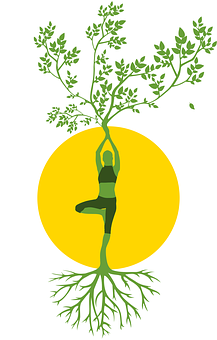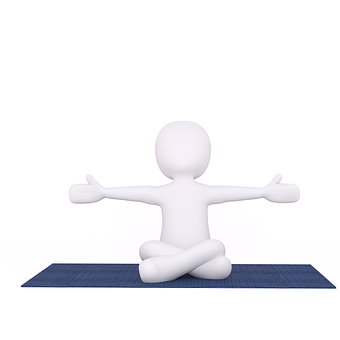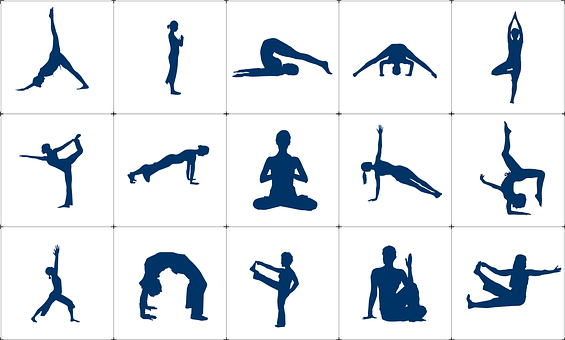Patanjali (帕坦加利) 瑜珈經 Yoga Sutra
Patanjali (帕坦加利) 在瑜珈經 Patanjali‘s Yoga Sutra 中講述達到瑜珈(身心靈合一)的八種必須步驟,就是所謂的Ashtanga Yoga (八支瑜珈),透過八支瑜珈的練習,那些不純潔便會被智慧之光去除,引向明辨之境。
瑜珈八支中
第1、2是生活中的內在自我約束及外在社會倫理規範;1.Yama 持戒 2.Niyama 精進
第3、第4體位法及生命能量呼吸控制屬於身體與心的調整;3.Asana 體位法 4.Pranayama 生命能量呼吸控制法
第5~第7屬於靈性力量的修持;5.Pratyahara 感官收攝 6.Dharana 心靈集中 7.Dhyana 冥想
第8三摩地是靈性修持的最高層次,每一個都是同樣重要和必須的。
先簡單列出瑜珈八支如下,後面我們再詳細討論
1.Yama 持戒
2.Niyama 精進
3.Asana 體位法
4.Pranayama 生命能量呼吸控制法
5.Pratyahara 感官收攝
6.Dharana 心靈集中
7.Dhyana 冥想
8.Samadhi 三摩地
瑜伽八支 8 Limbs of yoga
當一個人做到Ahimsa(不傷害)時,所有敵意都會停止。
b.Satya(不悖誠信、真實):是在思想、文字、語言及行為上不悖真理。
當一個人做到Satya(不悖誠信、真實)時,他的行為和結果都是信實的。
c.Asteya(不偷竊):從心理上減少慾望,生活上降低物質的要求,這樣便能遠離誘惑,不會佔有及享受別人擁有的。當一個人做到Asteya(不偷竊)時,所有的財富都會來臨。
d.Brahmacharya(心不離道、不縱慾):時時接觸神聖事物,研究宗教與自制,就能發展生命力與活力,產生勇氣與智慧。當一個人做到Brahmacharya(心不離道、不縱慾)時,將獲得精力、元氣。
e.Aparigraha(不貪婪):瑜伽行者使生活極簡單化,少欲知足,那麼真正需要的東西就會自己到來。當一個人做到Aparigraha(不貪婪)時,就會了解生命如何來,為何出生了。
2.Niyama(精進)。
a.Sauca(潔淨):身心淨化後對肉身的執著就會越來越小。
b.Santosa(適足、知足):維持現有的一切,即可獲得最高的喜悅。
c.Tapah(刻苦行):為身心淨化所做的修鍊。
d.Svadhyaya(研讀聖典、自我反省):研讀聖典可與神相應。
e.Isvara Pranidhana(安住於至上、虔誠奉獻):臣服於神將可達Samadhi(三摩地)的境界。
3.Asana(體位法):一種舒服穩定的姿勢,體位法學會後就不會被二元性干擾。
4.Pranayama(生命能量呼吸控制法):控制吸氣、呼氣、住氣。
5.Pratyahara(感官收攝):12秒身體跟心都完全沒有動作。
6.Dharana(心靈集中):144(12*12)秒身體跟心都沒有動作,感官作用也停止。
7.Dhyana(冥想):1,728(144*12)秒身心靜止。
8.Samadhi(三摩地):20,736(1728*12)秒身心寂然,達到的超意識境地,靈修者與至上合一。
整理自
Patanjali (帕坦加利) 瑜珈經 Yoga Sutra
- Yama(持戒) — 持戒是宇宙的宏誓大願,不受人、地、時間的限制。
當一個人做到Ahimsa(不傷害)時,所有敵意都會停止。
b.Satya(不悖誠信、真實):是在思想、文字、語言及行為上不悖真理。
當一個人做到Satya(不悖誠信、真實)時,他的行為和結果都是信實的。
c.Asteya(不偷竊):從心理上減少慾望,生活上降低物質的要求,這樣便能遠離誘惑,不會佔有及享受別人擁有的。當一個人做到Asteya(不偷竊)時,所有的財富都會來臨。
d.Brahmacharya(心不離道、不縱慾):時時接觸神聖事物,研究宗教與自制,就能發展生命力與活力,產生勇氣與智慧。當一個人做到Brahmacharya(心不離道、不縱慾)時,將獲得精力、元氣。
e.Aparigraha(不貪婪):瑜伽行者使生活極簡單化,少欲知足,那麼真正需要的東西就會自己到來。當一個人做到Aparigraha(不貪婪)時,就會了解生命如何來,為何出生了。
2.Niyama(精進)。
a.Sauca(潔淨):身心淨化後對肉身的執著就會越來越小。
b.Santosa(適足、知足):維持現有的一切,即可獲得最高的喜悅。
c.Tapah(刻苦行):為身心淨化所做的修鍊。
d.Svadhyaya(研讀聖典、自我反省):研讀聖典可與神相應。
e.Isvara Pranidhana(安住於至上、虔誠奉獻):臣服於神將可達Samadhi(三摩地)的境界。
3.Asana(體位法):一種舒服穩定的姿勢,體位法學會後就不會被二元性干擾。
4.Pranayama(生命能量呼吸控制法):控制吸氣、呼氣、住氣。
5.Pratyahara(感官收攝):12秒身體跟心都完全沒有動作。
6.Dharana(心靈集中):144(12*12)秒身體跟心都沒有動作,感官作用也停止。
7.Dhyana(冥想):1,728(144*12)秒身心靜止。
8.Samadhi(三摩地):20,736(1728*12)秒身心寂然,達到的超意識境地,靈修者與至上合一。
整理自
Patanjali (帕坦加利) 瑜珈經 Yoga Sutra
8 LIMBS OF YOGA
Patanjali (Patanjali) in the Yoga Sutra Patanjali's Yoga Sutra describes the eight necessary steps to reach yoga (the unity of body and mind), the so-called Ashtanga Yoga. Through the practice of the eight branches, those Impurity will be removed by the light of wisdom, leading to the realm of discernment.
The first and second of the eight branches of yoga are the internal self-discipline and external social ethical norms in life; 1. Yama holds the precepts 2. Niyama diligently
The third and fourth asanas and life energy breathing control belong to the adjustment of body and mind; 3. Asana asanas 4. Pranayama life energy breathing control method
The fifth to seventh belong to the practice of spiritual power; 5. Pratyahara sensory capture 6. Dharana mind concentration 7. Dhyana meditation
The eighth samadhi is the highest level of spiritual practice, each of which is equally important and necessary.
Let’s briefly list the eight branches of Yoga as follows, and we will discuss them in detail later
1.Yama keeps the precepts
2.Niyama diligence
3.Asana asana
4. Pranayama Life Energy Breathing Control Method
5.Pratyahara sensory capture
6. Dharana is focused
7. Dhyana Meditation
8.Samadhi Samadhi
FOR MORE
Yama (holding the precepts)-preserving the precepts is the grand vow of the universe, not limited by man, place, or time.
a. Ahimsa (do not harm): Do not intentionally harm any life with thoughts, words, or actions. On the negative side, it means not killing, on the positive side, it means love. Following Ahimsa can be without fear or anger.
When one does Ahimsa (do not hurt), all hostility will cease.
b.Satya (non-contrary to honesty and truth): is not contrary to the truth in thought, words, language and behavior.
When a person does Satya (not against integrity and truth), his behavior and results are faithful.
c. Asteya (Don't steal): Reduce the desire psychologically, and reduce the material requirements in life, so that you can stay away from temptation, and will not possess and enjoy what others have. When one does Asteya (no stealing), all wealth will come.
d.Brahmacharya (the heart does not deviate from the way, does not indulge in lust): Contacting sacred things from time to time, studying religion and self-control can develop vitality and vitality, and produce courage and wisdom. When a person achieves Brahmacharya (heart does not deviate from the way, does not indulge), one will gain energy and vitality.
e.Aparigraha (not greedy): Yogis make life extremely simple and want less contentment, then what is really needed will come by itself. When one achieves Aparigraha (not greedy), one will understand how life came and why it was born.
2. Niyama (hardened).
a.Sauca (cleansing): After the body and mind are purified, the attachment to the body will become smaller and smaller.
b. Santosa (satisfaction, contentment): Maintaining everything that is available, you can get the highest joy.
c.Tapah (hard work): the repair chain for the purification of the body and mind.
d. Svadhyaya (studying the scriptures, self-reflection): studying the scriptures can correspond to God.
e. Isvara Pranidhana (to live in the supremacy, devoutly devotion): surrender to the gods will reach the realm of Samadhi (Samadhi).
3. Asana (Asana): A comfortable and stable posture, after learning the Asana, it will not be disturbed by duality.
4. Pranayama (Life Energy Breathing Control Method): Control inhale, exhale, and hold breath.
5. Pratyahara (sensory capture): There is no movement of body and mind for 12 seconds.
6. Dharana (mind concentration): 144 (12*12) seconds neither the body nor the mind move, and the sensory function stops.
7. Dhyana (meditation): 1,728 (144*12) seconds of mind and body still.
8. Samadhi (Samadhi): 20,736 (1728*12) seconds of physical and mental silence, reaching the super-conscious state, the spiritual practitioner is one with the supreme.
Organized from
Patanjali Yoga Sutra




